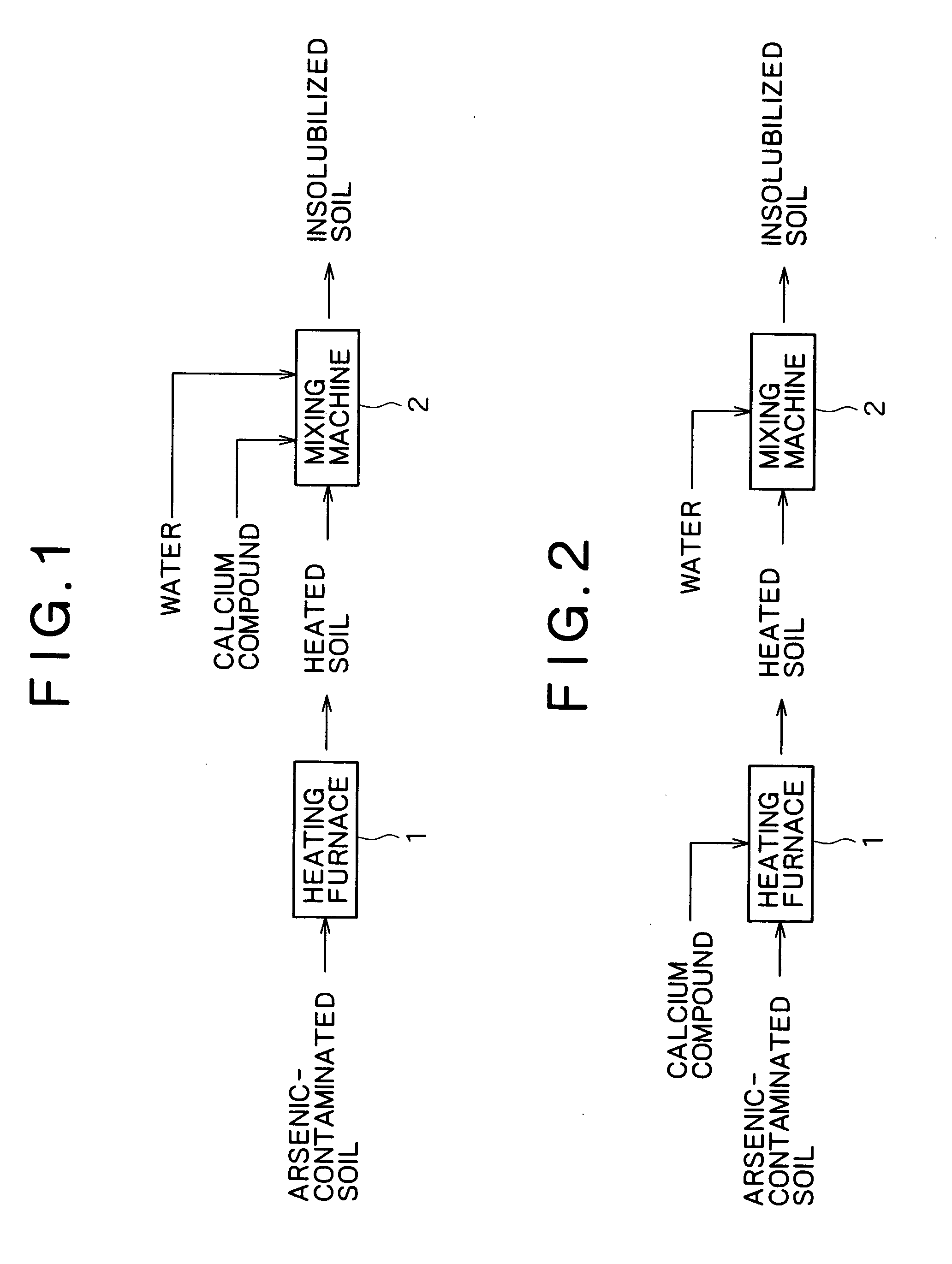Method for treatment of arsenic-contaminated soil
a technology for arsenic contamination and soil, applied in the field of arsenic contamination soil treatment, can solve the problems of heavy metal contamination of soil, no effective way to make arsenic compounds harmless, and the disadvantage of post-treatment for neutralizing washed soils, etc., and achieve the effect of reducing the level of leachable arseni
- Summary
- Abstract
- Description
- Claims
- Application Information
AI Technical Summary
Benefits of technology
Problems solved by technology
Method used
Image
Examples
example 1
[0042]The following four experiments Nos. 1 to 4 were carried out in Comparative Example. A sample of arsenic-contaminated soil (Kanto loam) containing 0.097 mg / L of leachable arsenic was obtained. The sample (100 pbw) was thoroughly mixed with water and slaked lime or quick lime in different quantities as follows.
40 pbw of water and 5 pbw of slaked lime in No. 1.
40 pbw of water and 7 pbw of slaked lime in No. 2.
40 pbw of water and 12 pbw of slaked lime in No. 3.
40 pbw of water and 5 pbw of quick lime in No. 4.
The mixtures were allowed to stand at room temperature. After 1 day, 7 days, and 28 days of ageing, the mixtures were tested for arsenic leaching according to the method specified in Environmental Quality Standards for Soil Pollution (Notification No. 46) of the Japanese Ministry of Environment Agency. The results of the test are shown in Table 3.
TABLE 3Amount of arsenicwhich leached fromtreated soil (mg / L)AmountAfterAfterAfterAmount of calciumof waterHeat1-day7-day28-dayExper...
example 2
[0045]The following two experiments Nos. 9 and 10 were carried out in Example 2. A sample of arsenic-contaminated soil (Kanto loam) containing 0.109 mg / L of leachable arsenic was obtained from the same location as in Comparative Example. This arsenic content is about four times as high as that in Example 1. The sample was heated at 550° C. for 20 minutes in a heating furnace in the atmosphere of air. The heated sample (100 pbw) was thoroughly mixed with water and quick lime in different quantities as follows.
40 pbw of water and 3 pbw of quick lime in No. 9.
40 pbw of water and 5 pbw of quick lime in No. 10.
[0046]The mixtures were allowed to stand at room temperature. After 1 day, 7 days, and 28 days of ageing, the mixtures were tested for arsenic leaching according to the method specified in Notification No. 46 of the Japanese Environment Agency. The results of the test are shown in Table 5.
TABLE 5Amount of arsenicwhich leached fromtreated soil (mg / L)AmountAfterAfterAfterExperimentAm...
example 3
[0048]The following three experiments Nos. 11 to 13 were carried out in Example 3. A sample of arsenic-contaminated soil (Kanto loam) containing about 3 to 4 times as much leachable arsenic as that in Example 2 was obtained from the same location as in Comparative Example. The sample (100 pbw) was mixed with quick lime (3 pbw in No. 11, 5 pbw in No. 12, and 10 pbw in No. 13). The mixture was heated at 550° C. for 20 minutes in a heating furnace in the atmosphere of air. The heated mixture (100 pbw) was thoroughly mixed with water (40 pbw). The mixtures were allowed to stand at room temperature. After 1 day, 7 days, and 28 days of ageing, the mixtures were tested for arsenic leaching according to the method specified in Notification No. 46 of the Japanese Environment Agency. The results of the test are shown in Table 6.
TABLE 6Contaminated soilArsenicLeachableArsenicLeachedcontent inAmountarsenic inExperimentcontentarsenicAmount of calciumheated soilof watertreated soilNo.(mg / kg)(mg / L...
PUM
 Login to view more
Login to view more Abstract
Description
Claims
Application Information
 Login to view more
Login to view more - R&D Engineer
- R&D Manager
- IP Professional
- Industry Leading Data Capabilities
- Powerful AI technology
- Patent DNA Extraction
Browse by: Latest US Patents, China's latest patents, Technical Efficacy Thesaurus, Application Domain, Technology Topic.
© 2024 PatSnap. All rights reserved.Legal|Privacy policy|Modern Slavery Act Transparency Statement|Sitemap


